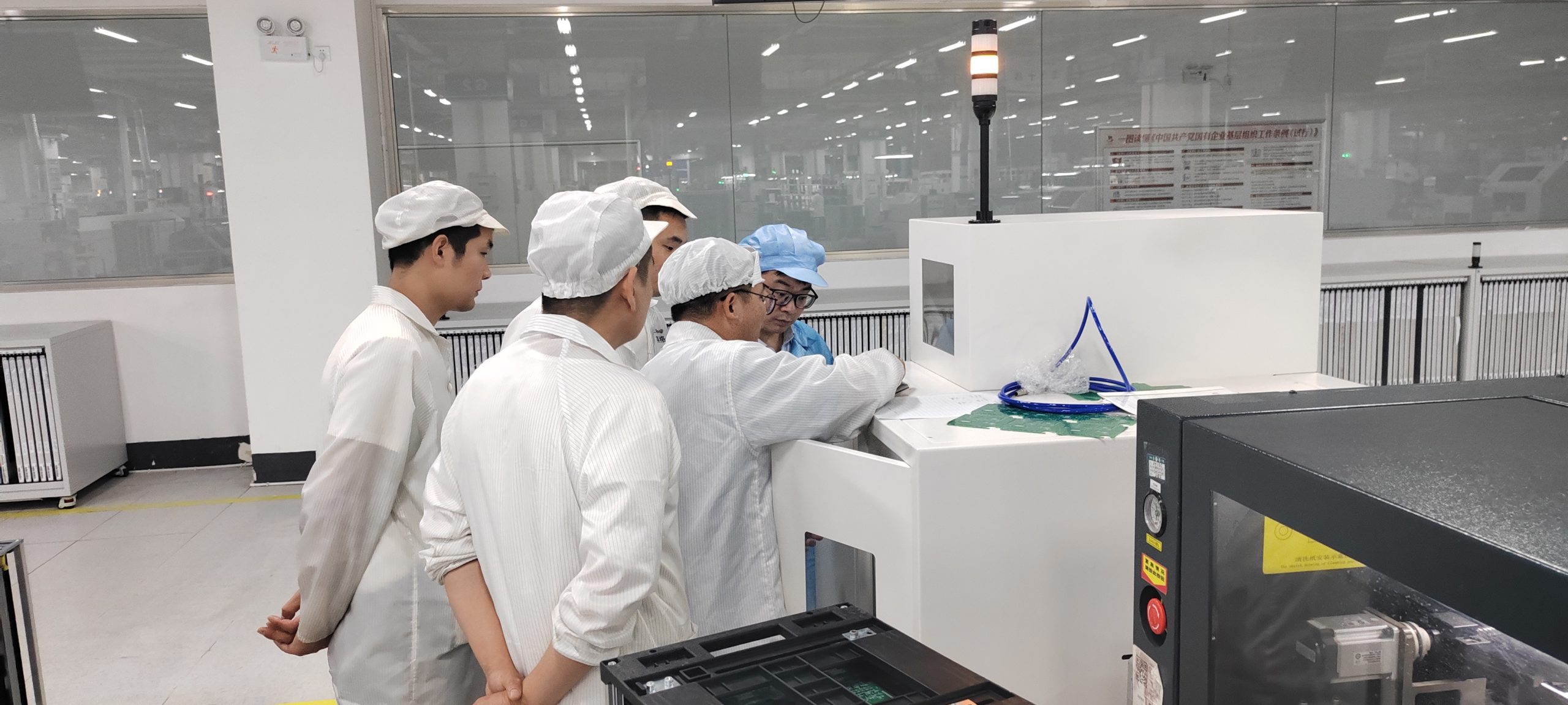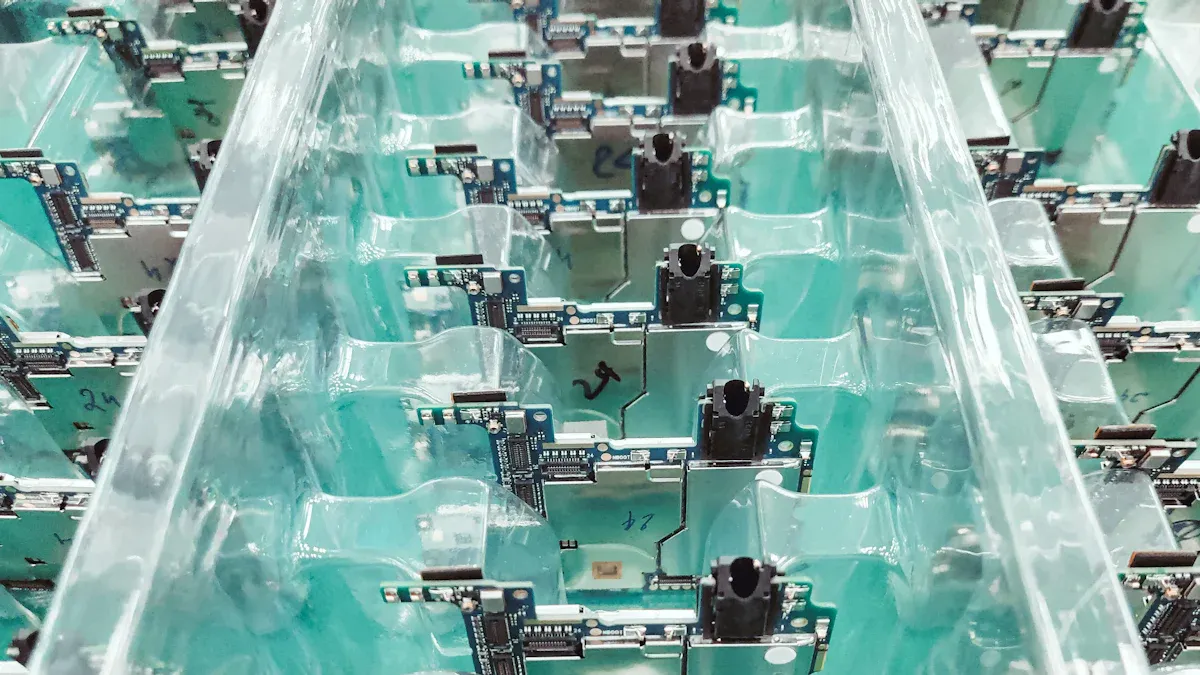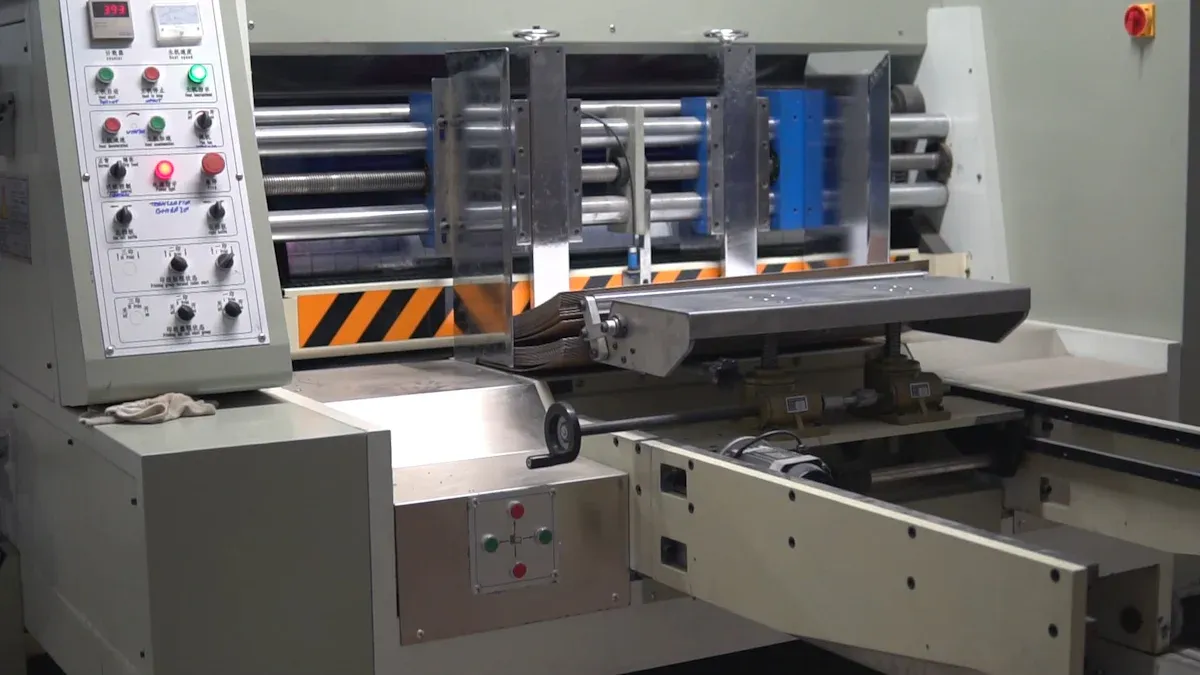
You will notice a clear distinction between Loader and Unloader in SMT lines. Loaders feed bare PCBs from magazines into the production line, while Unloaders remove completed boards and restack them in magazines. These machines play a key role in protecting PCBs and maintaining high throughput. Common issues in SMT lines—such as:
-
Component misalignment
-
Solder joint defects
-
Component damage
—are often reduced when Loader and Unloader systems handle boards carefully and consistently.
Key Takeaways
-
Loaders feed bare PCBs into the SMT line, starting the assembly process, while unloaders remove finished boards for inspection or packaging.
-
Proper placement of loaders and unloaders in the SMT line prevents bottlenecks and maintains a smooth workflow.
-
Automated loaders and unloaders enhance production efficiency by reducing manual labor and minimizing errors.
-
Both machines can be adjusted for different PCB sizes, providing flexibility in production without needing extra equipment.
-
Using automated systems improves product quality by protecting PCBs from damage and ensuring consistent handling.
Loader and Unloader Overview

Loader Definition
You will find that the loader is the first machine in the SMT line. It automatically places unmounted PCB boards into the production flow. The loader sends these boards to the suction machine, which positions them onto the track of the solder paste printer. This step marks the beginning of the SMT process and sets the pace for the entire line. You do not need to manually handle each PCB, which saves time and reduces errors. The loader uses adjustable magazine racks, so you can work with different magazine sizes. User-friendly controls make operation simple, and robust construction ensures the loader works reliably in high-volume environments.
Tip: Always check the guide rail width and set the feeding steps before starting the loader. This helps prevent misfeeds and keeps your line running smoothly.
Here are the main steps for operating a loader:
-
Turn on the power supply and adjust the guide rail width.
-
Select the pitch and adjust the push rod for smooth feeding.
-
Load the PCB and press the automatic key to start.
-
Follow safety protocols for voltage and air pressure.
Unloader Definition
The unloader sits at the end of the SMT line. Its job is to remove finished PCBs from the assembly line and stack them in magazines. You can rely on the unloader to handle boards gently, preventing damage during transition. The unloader automatically collects and organizes completed boards for inspection, packaging, or storage. This process preserves the quality of your products and streamlines workflow.
|
Definition |
Responsibilities |
|---|---|
|
The PCB unloader serves the opposite function, automatically removing completed PCBs from the SMT assembly line. |
Separates and organizes finished boards for inspection, packaging, or storage, preserving their quality. |
Loader and Unloader machines integrate seamlessly with SMT lines. Features like SMEMA compatibility and dual operating modes support both loading and unloading, giving you flexibility and saving valuable floor space. You will notice that these machines reduce wait times and increase throughput, making your production line more efficient.
Key Differences

Functions
You will see that Loader and Unloader machines serve opposite functions in the SMT line. The loader feeds bare PCBs into the production line, starting the assembly process. The unloader removes finished boards and stacks them for inspection or packaging. Both machines automate their tasks, which reduces manual labor and lowers the risk of errors.
|
Machine Type |
Role in SMT Process Flow |
Key Features |
|---|---|---|
|
Loader |
Feeds PCBs into the production line |
Adjustable for various board sizes, PLC for precise operation |
|
Unloader |
Manages the exit of assembled boards |
Prevents bottlenecks, adaptable to different board dimensions |
You can rely on the loader to keep the line supplied with boards. The unloader ensures that completed boards leave the line smoothly, preventing jams and delays.
Placement
You will find the loader at the very beginning of the SMT line. It loads PCBs onto the conveyor, setting the pace for the entire process. The unloader sits at the end of the line, where it collects finished boards and places them in magazines.
|
Machine Type |
Function |
Location in SMT Line |
|---|---|---|
|
SMT Loader |
Automatically stacks and loads PCBs onto the conveyor |
At the beginning of the SMT line |
|
SMT Unloader |
Receives the completed PCBs on magazines after manufacture |
At the end of the SMT line |
Proper placement of Loader and Unloader machines keeps your workflow organized. You avoid bottlenecks and maintain a steady rhythm in production.
PCB Handling
Loader and Unloader machines use different techniques to protect and move PCBs. The loader streamlines the loading process, reducing manual contact and handling errors. The unloader stacks or transports finished boards with care, minimizing the risk of damage.
|
Feature |
PCB Loader |
PCB Unloader |
|---|---|---|
|
Purpose |
Automates the loading of PCBs into production lines |
Automates the unloading of PCBs from production lines |
|
Handling Technique |
Streamlines loading, reduces manual labor |
Neatly stacks or transports PCBs, minimizing errors |
|
Types |
Automatic, manual, magazine loaders |
Magazine, conveyor, robotic unloaders |
|
Efficiency |
Increases production efficiency |
Enhances production flow, reduces delays |
|
Human Intervention |
Minimizes handling errors by automating processes |
Reduces human contact with PCBs to prevent damage |
|
Investment Consideration |
High initial cost but long-term labor savings |
Similar investment with focus on efficiency and error reduction |
Note: Special gas circuit designs and secure clamps in both machines help prevent PCB breakage. Automated handling also protects soldered components and keeps boards safe during transfer.
Production Flow
Loader and Unloader machines shape the flow of your SMT line. The loader automates the start of production, while the unloader manages the exit of finished boards. Both machines synchronize with conveyor systems and adjust for different board sizes. Automatic controls reduce manual intervention and optimize the loading and unloading sequence.
|
Functionality |
Description |
|---|---|
|
PCB Loading |
Automates the loading of PCBs onto the production line using conveyor systems or robotic arms. |
|
PCB Unloading |
Retrieves finished PCBs from the production line for further processing or packaging. |
|
Alignment and Orientation |
Ensures proper alignment of PCBs using vision systems or sensors for accurate placement. |
|
Conveyor System Integration |
Synchronizes with the production line’s speed to minimize workflow disruptions. |
|
PCB Size Compatibility |
Handles various PCB sizes, adjustable to meet specific production line requirements. |
|
Automatic Control |
Operates automatically, reducing manual intervention and optimizing loading/unloading sequences. |
You will notice that Loader and Unloader integration improves throughput and product quality. Automation reduces manual handling, lowers labor needs, and minimizes human error. Buffer conveyors balance line flow and prevent bottlenecks. Antistatic belts and stable transport designs protect sensitive electronics. Continuous board transfer keeps production moving and boosts efficiency.
Tip: When you set up your SMT line, make sure Loader and Unloader machines match your board sizes and production speed. This helps you avoid jams and keeps your workflow smooth.
Comparison Table
When you compare Loader and Unloader machines in SMT lines, you see clear differences in their roles and benefits. The table below highlights the most important features side by side:
|
Feature |
Loader Machine |
Unloader Machine |
|---|---|---|
|
Primary Function |
Automatically loads PCBs into the solder printing machine |
Unloads completed PCBs from the solder printing machine |
|
Purpose |
Enhances productivity and reduces manual setup |
Streamlines production by minimizing manual labor |
|
Efficiency Impact |
Speeds up the loading process |
Ensures timely unloading to avoid delays |
Tip: Use this table to quickly identify which machine fits your production needs.
You notice that Loader machines focus on accuracy when placing PCBs. They prevent misalignment and keep boards clean. This attention to detail helps you maintain high productivity and better yield. Loader machines also offer durability. You do not need to replace them often, which saves you money over time.
Unloader machines help you avoid delays at the end of the line. They remove finished boards quickly and organize them for inspection or packaging. You rely on their smooth operation to keep your workflow moving.
Both Loader and Unloader machines use adjustable magazine racks. You can change settings easily with user-friendly controls. This design makes your job simpler and helps you handle different board sizes without trouble.
Note: When you choose Loader and Unloader machines, look for models with strong construction and easy adjustments. These features improve operational efficiency and protect your PCBs.
You see that each machine plays a unique part in your SMT line. Loader machines start the process with speed and precision. Unloader machines finish the process by keeping boards safe and organized. When you match the right machine to your needs, you boost your production and protect your products.
Practical Impact
Efficiency
You can boost your SMT line’s efficiency by using automated Loader and Unloader machines. Automation speeds up the movement of PCB boards and reduces the need for manual labor. You save time and increase output. Staff can manage several machines at once, which helps you run a leaner operation. You also notice that operation time drops, and equipment utilization rises. The table below shows how automation improves your workflow:
|
Improvement Aspect |
Description |
|---|---|
|
Work Efficiency |
Automation allows for faster processing of PCB boards. |
|
Labor Costs |
Fewer staff are needed to operate multiple machines. |
|
Equipment Utilization |
Automated systems increase output and machine use. |
|
Operation Time |
You save significant time during production. |
|
Cost Reduction |
Production costs decrease by 30% to 50% with automation. |
Tip: After minimal training, you can operate Loader and Unloader machines easily. This makes your SMT line smarter and more productive.
Quality
Loader and Unloader machines help you protect your PCBs and maintain high product quality. Automated loading keeps boards safe from scratches and bending. Unloaders separate defective boards from good ones, so you avoid mixing errors. Vision systems inspect each PCB for defects, ensuring only quality boards move forward. The table below highlights how these machines support quality control:
|
Evidence Type |
Description |
|---|---|
|
Loader Machine |
Automates loading, keeps productivity high, and ensures smooth PCB flow. |
|
Unloader Machine |
Separates defective from non-defective PCBs, reducing manual mistakes. |
|
Quality Control |
Vision systems inspect boards for defects, improving overall product quality. |
Note: You reduce human contact with PCBs, which lowers the risk of damage and keeps your products reliable.
Automation
You can achieve a higher level of automation by integrating Loader and Unloader machines with other SMT equipment. Dual-rails SMT Unloaders streamline PCB handling and keep your workflow smooth. SMEMA interfaces allow machines to communicate, which reduces bottlenecks and keeps production moving. You benefit from a smarter, more connected SMT line.
-
Loader and Unloader machines work with conveyors, printers, and inspection systems.
-
You experience fewer workflow interruptions and better production speed.
-
Automation helps you maintain consistent quality and throughput.
🚀 When you automate your SMT line, you create a safer, faster, and more reliable production environment.
You see that Loader and Unloader machines perform opposite tasks in your SMT line. Loader and Unloader systems keep your boards moving and protect them from damage. You can improve your setup by using automatic feeders, barcode reading, and 3D inspection before reflow.
|
Best Practice |
Description |
|---|---|
|
Automatic Setups |
Machines perform changeovers, boosting productivity. |
|
Autoloading Feeders |
Shorten downtime and keep production steady. |
You may notice new trends, such as AI and robotics, making SMT lines smarter and more efficient. Consider these best practices to optimize your own production.
-
AI and machine learning help predict maintenance needs.
-
AGVs and automation increase speed and quality.
FAQ
What is the main difference between a Loader and an Unloader in SMT lines?
You use a Loader to feed bare PCBs into the SMT line. You rely on an Unloader to remove finished boards and stack them in magazines. Each machine works at opposite ends of the production process.
Can you adjust the Loader and Unloader machines for different PCB sizes?
You can adjust both machines for various PCB sizes. Most models offer easy controls and adjustable magazine racks. This flexibility helps you handle different production requirements without extra equipment.
Do Loader and Unloader machines improve product quality?
You protect PCBs from scratches and bending by using automated Loader and Unloader machines. These systems reduce manual handling and errors. You maintain higher product quality and reliability in your SMT line.
How do Loader and Unloader machines affect production speed?
You increase production speed with automated Loader and Unloader machines. Automation reduces wait times and keeps boards moving. You finish more products in less time and avoid bottlenecks.
